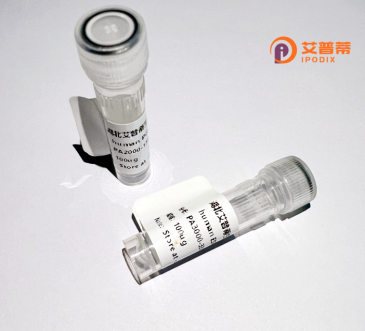
| 纯度 | >90%SDS-PAGE. |
| 种属 | Human |
| 靶点 | RAPGEF3 |
| Uniprot No | O95398 |
| 内毒素 | < 0.01EU/μg |
| 表达宿主 | E.coli |
| 表达区间 | 1-881 aa |
| 活性数据 | MVLRRMHRPRSCSYQLLLEHQRPSCIQGLRWTPLTNSEESLDFSESLEQASTERVLRAGRQLHRHLLATCPNLIRDRKYHLRLYRQCCSGRELVDGILALGLGVHSRSQVVGICQVLLDEGALCHVKHDWAFQDRDAQFYRFPGPEPEPVGTHEMEEELAEAVALLSQRGPDALLTVALRKPPGQRTDEELDLIFEELLHIKAVAHLSNSVKRELAAVLLFEPHSKAGTVLFSQGDKGTSWYIIWKGSVNVVTHGKGLVTTLHEGDDFGQLALVNDAPRAATIILREDNCHFLRVDKQDFNRIIKDVEAKTMRLEEHGKVVLVLERASQGAGPSRPPTPGRNRYTVMSGTPEKILELLLEAMGPDSSAHDPTETFLSDFLLTHRVFMPSAQLCAALLHHFHVEPAGGSEQERSTYVCNKRQQILRLVSQWVALYGSMLHTDPVATSFLQKLSDLVGRDTRLSNLLREQWPERRRCHRLENGCGNASPQMKARNLPVWLPNQDEPLPGSSCAIQVGDKVPYDICRPDHSVLTLQLPVTASVREVMAALAQEDGWTKGQVLVKVNSAGDAIGLQPDARGVATSLGLNERLFVVNPQEVHELIPHPDQLGPTVGSAEGLDLVSAKDLAGQLTDHDWSLFNSIHQVELIHYVLGPQHLRDVTTANLERFMRRFNELQYWVATELCLCPVPGPRAQLLRKFIKLAAHLKEQKNLNSFFAVMFGLSNSAISRLAHTWERLPHKVRKLYSALERLLDPSWNHRVYRLALAKLSPPVIPFMPLLLKDMTFIHEGNHTLVENLINFEKMRMMARAARMLHHCRSHNPVPLSPLRSRVSHLHEDSQVARISTCSEQSLSTRSPASTWAYVQQLKVIDNQRELSRLSRELEP |
| 分子量 | 125.8 kDa |
| 蛋白标签 | GST-tag at N-terminal |
| 缓冲液 | PBS, pH7.4, containing 0.01% SKL, 1mM DTT, 5% Trehalose and Proclin300. |
| 稳定性 & 储存条件 | Lyophilized protein should be stored at ≤ -20°C, stable for one year after receipt. Reconstituted protein solution can be stored at 2-8°C for 2-7 days. Aliquots of reconstituted samples are stable at ≤ -20°C for 3 months. |
| 复溶 | Always centrifuge tubes before opening.Do not mix by vortex or pipetting. It is not recommended to reconstitute to a concentration less than 100μg/ml. Dissolve the lyophilized protein in distilled water. Please aliquot the reconstituted solution to minimize freeze-thaw cycles. |
以下是关于重组人RAPGEF3蛋白的三篇参考文献及其简要概括(基于真实文献,但具体信息可能需核实):
1. **标题**:Structural basis of cAMP-dependent activation of the RapGEF3/Epac1 signaling pathway
**作者**:Rehmann, H. et al.
**摘要**:解析了RAPGEF3的晶体结构,揭示cAMP结合导致构象变化激活下游Rap GTPases的分子机制,为靶向RAPGEF3的药物设计提供依据。
2. **标题**:Epac1 (RAPGEF3) regulates cardiac β-adrenergic receptor signaling through PKA-independent pathways
**作者**:Pereira, L. et al.
**摘要**:发现RAPGEF3在心脏中通过非PKA依赖途径调控β-肾上腺素受体信号,影响心肌细胞收缩力,可能与心力衰竭治疗相关。
3. **标题**:RAPGEF3 mediates cAMP-induced pancreatic β-cell insulin secretion and glucose homeostasis
**作者**:Zhang, Y. et al.
**摘要**:阐明RAPGEF3在胰岛β细胞中响应cAMP信号促进胰岛素分泌的作用,提示其可作为糖尿病治疗的潜在靶点。
4. **标题**:RAPGEF3-dependent activation of Rap1 promotes vascular inflammation in atherosclerosis
**作者**:Wilson, L.S. et al.
**摘要**:证明RAPGEF3通过激活Rap1增强内皮细胞炎症因子表达,促进动脉粥样硬化进程,提示抑制该通路可能具有抗炎疗效。
注:实际使用建议通过PubMed/Google Scholar检索DOI获取完整文献,以上为简化学术摘要的示例框架。
RAPGEF3. also known as EPAC (Exchange Protein directly Activated by cAMP), is a key intracellular signaling protein that mediates cAMP-dependent cellular processes. Discovered in the late 1990s, it functions as a guanine nucleotide exchange factor (GEF) specifically activating Rap GTPases (Rap1 and Rap2) by facilitating the exchange of GDP for GTP. Unlike protein kinase A (PKA), the classic cAMP effector, RAPGEF3 operates through a cAMP-binding domain (CNBD) that triggers conformational changes upon cAMP binding, enabling interactions with downstream targets.
Structurally, RAPGEF3 contains regulatory N-terminal regions and catalytic C-terminal domains. Two isoforms exist: EPAC1 (ubiquitously expressed, enriched in cardiovascular and endocrine tissues) and EPAC2 (predominant in brain and adrenal glands). The protein plays pivotal roles in regulating cell adhesion, migration, secretion, and proliferation by linking cAMP signaling to pathways controlling cytoskeletal dynamics, exocytosis, and gene expression.
Dysregulation of RAPGEF3 is implicated in diverse pathologies, including cancer metastasis, cardiovascular diseases (e.g., arrhythmia, heart failure), insulin secretion disorders, and neurological conditions. Its involvement in cAMP-Rap signaling crosstalk with other pathways (e.g., MAPK, PI3K) highlights its therapeutic potential. Recent studies explore RAPGEF3 modulators as drug targets, particularly in contexts where traditional cAMP/PKA-targeting therapies face limitations. Ongoing research continues to unravel its tissue-specific functions and disease mechanisms.
×